Mapping the Future of Green Hydrogen: Integrated Analysis of Poland and the EU’s Development Pathways to 2050
Abstract
:1. Introduction
- -
- By 2024—installation of at least 6 GW of electrolyzers capacity and annual production of at least 1 million tons of hydrogen from RES;
- -
- By 2030—installation of at least 40 GW of electrolyzers capacity and annual production of at least 10 million tons of hydrogen from RES.
2. Overview of Hydrogen Market Development Forecast
- Analysis of the potential of hydrogen technologies in Poland to 2030 with an outlook to 2040—published by the Ministry of Climate and Environment (MCE), 2021 [7]. On the basis of this analysis forecasts, the assumptions of the Polish Hydrogen Strategy [6] were formulated. It contains three scenarios: business as usual (BAU), a central scenario adapted to the Polish Hydrogen Strategy (PHS), and a scenario in line with the EU’s Fit for 55 package.
- Green hydrogen from RES in Poland. Polish Wind Energy Association (PWEA), the Lower Silesian Institute for Energy Studies (LSIES), 2021 [8].
- Hydrogen Roadmap Europe. A Sustainable Pathway for the European Energy transition. Fuel Cells and Hydrogen 2 Joint Undertaking 2019, fh.europa.eu [9]. It includes two scenarios: business as usual (BAU) and a scenario with more ambitious hydrogen development goals (Ambitious).
- Hydrogen Forecast to 2050. Energy Transition Outlook 2022. DNV [13].
- Paris Agreement Compatible (PAC) Scenarios for Energy Infrastructure, 2020. German Federal Ministry of Economics and Energy (BMWi). Co-creation Report prepared by: Global Renewable Energy Community (REN21), European Environmental Bureau (EEB), Renewables Grid Initiative (RGI and Climate Action Network Europe (CAN) [16].
- European Commission 2021. Fit for 55 package—MIX H2 scenario [17].
- Achieving the Paris Climate Agreement Goals. University of Technology Sydney (UTS), University of Melbourne, and German Aerospace Centre, 2019 [18].
- The Net Zero scenario, reaching carbon neutrality in the EU by 2050. EC JRC 2021 [19].
- BP Energy Outlook, 2023 edition. The hydrogen demand projections in this publication were made for two scenarios: Net-zero and Accelerated [20].
- McKinsey & Company (2020). Net-Zero Europe Decarbonization pathways and socioeconomic implications. McKinsey & Company [21].
3. Technological Solutions for Green Hydrogen Production
- Separation from coke oven gas;
- Hydrothermal carbonization;
- As a by-product of refining processes;
- Pyrolysis and thermal waste treatment;
- Fermentation and other biological processes [28].
3.1. Types of Electrolyzers
3.2. Cost of Electrolyzers
4. Costs of Hydrogen Production
5. Technological Solutions for Hydrogen Utilization
5.1. Electricity and District Heat Generation
- Proton exchange membrane fuel cells—PEMFCs;
- Alkaline fuel cells—AFCs;
- Phosphoric-acid fuel cells—PAFCs;
- Solid-oxide fuel cells—SOFCs;
- Molten-carbonate fuel cells—MCFCs.
5.2. Transportation
- Modernization of rolling stock (vehicles and alternative fuel infrastructure);
- Supporting low-emission transport, including switching a road transport to rail;
- Promoting means of transportation powered by alternative energy sources (reducing the dependence of the transport sector on conventional fuels).
5.3. Industry
- Reforming—which aims to raise the octane number of the fuel;
- Hydrotreating, hydrodesulfurization—which allows the reduction of the content of sulfur, nitrogen, and oxygen compounds and get rid of unsaturated compounds that reduce fuel stability;
- Hydrocracking—which involves converting heavy petroleum fractions such as lubricants or heavy oils into light oils and gasoline [68].
6. Methods of Calculation
- BEN—Belgium, Luxembourg, the Netherlands;
- CEU—Austria, Switzerland, Czech Republic, Hungary, Slovakia, Slovenia;
- IBI—Italy, Malta, Portugal, Spain;
- NTH—Denmark, Estonia, Finland, Lithuania, Latvia, Norway, Sweden;
- STH—Bulgaria, Greece, Cyprus, Croatia, Romania;
- UKI—Ireland, United Kingdom;
- DEU—Germany;
- FRA—France;
- POL—Poland.
7. Modeling Assumptions
7.1. Scenarios
- (1)
- The EU Climate Neutrality Scenario (fit)—a baseline scenario assuming approximately 90% emission reductions in 2050 vs. 1990 and zero net emissions (including removals) across the EU+ economy. This scenario assumes the achievement of the targets set in the Fit for 55 package for given time frames with the ultimate goal of achieving climate neutrality by 2050.
- (2)
- The EU Climate Neutrality Scenario with low CCS utilization in the EU+ (low_ccs)—assumes the same overall conditions as above, except significantly lower (about 30% lower than in fit scenario) potential of carbon storage technology in the energy sector. This limitation applies to all CCS technologies but, from the system perspective, the most important is the reduced development of BECCS technology, as it is one of the few technologies capable of generating negative emissions in the energy sector. This scenario shows the impact of lower emission reduction potential in the power sector on CO2 and energy prices, which in turn may affect the demand for hydrogen.
- (3)
- The EU Climate Neutrality Scenario without new nuclear power plant in the EU+ (no_nuc)—scenario for achieving climate neutrality in the EU+ without wider development of nuclear power (no new nuclear power plants will be built and the existing power plants will be operating until the end of their lifetime). It is intended to provide an answer to the question of whether it is possible to generate the energy surplus needed to produce “green hydrogen” using mainly non-controllable RES sources.
- (4)
- The EU Climate Neutrality Scenario with a higher amount of “green hydrogen” available in the EU+ (hi_hyd)—a scenario assuming a higher potential for electrolyzers construction in the EU+ in comparison to the fit scenario and subsidies for hydrogen production in the 2025–2035 period. The subsidies are at the level of 15 EUR/GJ in 2025–2030, then decline to 5 EUR/GJ in 2035. There are no subsidies after 2035. The same level of subsidies was used in all regions except Poland. In the case of Poland, due to very high electricity prices in 2030, the level of subsidies necessary to promote faster development of hydrogen production was about twice as high than for other regions.
7.2. Techno-Economic Parameters
7.3. Fuel Prices
8. Results
- ○
- CO2 allowance prices;
- ○
- Electricity and hydrogen demand;
- ○
- Electricity generation structure—including electricity generated from the “green hydrogen”;
- ○
- “Green hydrogen” production;
- ○
- “Green hydrogen” costs.
8.1. EU ETS Allowance Prices
- -
- With the low potential of CCS—especially BECCS—the marginal cost of CO2 abatement increases significantly (see Figure 7). This means that BECCS technology has a key impact in the period in which no emissions are allowed (around 2050). The “fit” scenario assumptions require the power sector to achieve negative emissions (offsetting emissions from other sectors) in the final year. The inability to do so raises the cost of reductions.
- -
- The lack of new nuclear power plants raises the marginal abatement cost in EU ETS.
- -
- The lowest CO2 marginal abatement costs are in the scenario hi_hyd. This scenario assumes the high potential of CCS, nuclear, and electrolyzers.
8.2. Electricity Generation Mix
8.3. Hydrogen Demand and Production
8.4. Hydrogen Cost
9. Conclusions
Author Contributions
Funding
Data Availability Statement
Conflicts of Interest
References
- European Commission. A Hydrogen Strategy for Climate-Neutral Europe. Brussels. 2020, p. 8. Available online: https://knowledge4policy.ec.europa.eu/publication/communication-com2020301-hydrogen-strategy-climate-neutral-europe_en (accessed on 15 March 2023).
- European Commission. Fit for 55: Delivering the EU’s 2030 Climate Target on the Way to Climate Neutrality. Brussels. 2021. Available online: https://eur-lex.europa.eu/legal-content/EN/TXT/?uri=CELEX%3A52021DC0550 (accessed on 15 March 2023).
- European Commission. Powering a Climate-Neutral Economy: An EU Strategy for Energy System Integration. Brussels, Com(2020) 299 Final. 2020, p. 9. Available online: https://eur-lex.europa.eu/legal-content/EN/ALL/?uri=CELEX%3A52020DC0299 (accessed on 20 March 2023).
- European Commission. REPowerEU: A Plan to Rapidly Reduce Dependence on Russian Fossil Fuels and Fast Forward the Green Transition. Brussels. 2022, p. 7. Available online: https://eur-lex.europa.eu/legal-content/EN/TXT/?uri=COM%3A2022%3A230%3AFIN (accessed on 21 March 2023).
- Tagliapietra, S. REPowerEU: Will EU Countries Really Make It Work? Bruegel. 18 May 2022. Available online: https://www.bruegel.org/blog-post/repowereu-will-eu-countries-really-make-it-work (accessed on 23 March 2023).
- Ministry of Climate and Environment. Polish Hydrogen Strategy Until 2030 with an Outlook Until 2040. Warsaw. 2 November 2021. Available online: https://www.gov.pl/web/klimat/polska-strategia-wodorowa-do-roku-2030 (accessed on 25 March 2023).
- Ministry of Climate and Environment. Analysis of the Potential of Hydrogen Technologies in Poland Until 2030 with an Outlook to 2040. Available online: https://klasterwodorowy.pl/images/zdjecia/9_Analiza_potencjalu_technologii_wodorowych_opracowanie.pdf (accessed on 26 March 2023).
- Polish Wind Energy Association; The Lower Silesian Institute for Energy Studies. Green Hydrogen from RES in Poland. Wroclaw. October 2021, pp. 114–143. Available online: http://psew.pl/en/wp-content/uploads/sites/2/2021/12/Report-Green-hydrogen-from-RES-75MB.pdf (accessed on 13 February 2022).
- European Commission. Hydrogen Roadmap Europe. A Sustainable Pathway for the European Energy Transition. Fuel Cells and Hydrogen 2 Joint Undertaking 2019. Available online: https://op.europa.eu/en/publication-detail/-/publication/0817d60d-332f-11e9-8d04-01aa75ed71a1/language-en (accessed on 27 March 2023).
- Tarvydas, D. The Role of Hydrogen in Energy Decarbonisation Scenarios—Views on 2030 and 2050; Publications Office of the European Union: Luxembourg, 2022; JRC131299; Available online: https://publications.jrc.ec.europa.eu/repository/handle/JRC131299 (accessed on 17 June 2023).
- IRENA. Global Hydrogen Trade to Meet the 1.5 °C Climate Goal: Part I—Trade Outlook for 2050 and Way Forward; International Renewable Energy Agency: Abu Dhabi, United Arab Emirates, 2022; Available online: https://www.irena.org/-/media/Files/IRENA/Agency/Publication/2022/Jul/IRENA_Global_hydrogen_trade_part_1_2022_.pdf (accessed on 6 May 2023).
- Oxford Institute for Energy Studies; Institute of Energy Economics at the University of Cologne. Contrasting European Hydrogen Pathways. An Analysis of Differing Approaches in Key Markets. March 2021. Available online: https://www.oxfordenergy.org/wpcms/wp-content/uploads/2021/03/Contrasting-European-hydrogen-pathways-An-analysis-of-differing-approaches-in-key-markets-NG166.pdf (accessed on 10 June 2023).
- DNV. Hydrogen Forecast to 2050. Energy Transition Outlook 2022. Available online: https://www.dnv.com/news/hydrogen-at-risk-of-being-the-great-missed-opportunity-of-the-energy-transition-226628 (accessed on 12 May 2023).
- Trinomics and LBST. Opportunities for Hydrogen Energy Technologies Considering the National Energy & Climate Plans, Fuel Cells and Hydrogen Joint Undertaking. Available online: https://trinomics.eu/project/opportunities-for-hy-drogen-in-necps/ (accessed on 6 April 2023).
- Wolf, A.; Zandre, N. Green Hydrogen in Europe: Do Strategies Meet Expectations? Available online: https://www.intereconomics.eu/contents/year/2021/number/6/article/green-hydrogen-in-europe-do-strategies-meet-expectations.html (accessed on 9 April 2023).
- German Federal Ministry of Economics and Energy (BMWi). Co-Creation Report Prepared by: Global Renewable Energy Community (REN21), European Environmental Bureau (EEB), Renewables Grid Initiative (RGI and Climate Action Network Europe (CAN). Paris Agreement Compatible (PAC) Scenarios for Energy Infrastructure. 2021. Available online: https://www.pac-scenarios.eu/project.html (accessed on 6 April 2023).
- European Commission. Fit for 55 Package—EC PRIMES MODEL, MIX H2 Scenario. Brussels. E3M Lab, University of Athens, Greece. 2021. Available online: https://commission.europa.eu/system/files/2021-07/revision-eu-ets_with-annex_en_0.pdf (accessed on 10 June 2023).
- Teske, S. (Ed.) Achieving the Paris Climate Agreement Goals. Global and Regional 100% Renewable Energy Scenarios with Non-Energy GHG Pathways for +1.5 °C and +2 °C; Springer: Cham, Switzerland, 2019. [Google Scholar] [CrossRef]
- EC JRC. The Net Zero Scenario, Reaching Carbon Neutrality in the EU by 2050. Towards Net-Zero Emissions in the EU Energy System by 2050. JRC118592. Available online: https://publications.jrc.ec.europa.eu (accessed on 20 June 2023).
- BP Energy Outlook. 2023 Edition. The Hydrogen Demand Projections in This Publication Were Made for Two Scenarios: Net-zero and Accelerated. Available online: https://www.bp.com/content/dam/bp/business-sites/en/global/corporate/pdfs/energy-economics/energy-outlook/bp-energy-outlook-2023.pdf (accessed on 2 June 2023).
- McKinsey & Company. Net-Zero Europe Decarbonization Pathways and Socioeconomic Implications; McKinsey & Company: Brussels, Belgium, 2020. [Google Scholar]
- Esposito, E.; Minotti, A.; Fontananova, E.; Longo, M.; Jansen, J.C.; Figoli, A. Green H2 Production by Water Electrolysis Using Cation Exchange Membrane: Insights on Activation and Ohmic Polarization Phenomena. Membranes 2022, 12, 15. [Google Scholar] [CrossRef] [PubMed]
- Suleman, F.; Dincer, I.; Agelin-Chaab, M. Environmental Impact Assessment and Comparison of Some Hydrogen Production Options. Int. J. Hydrogen Energy 2015, 40, 6976–6987. [Google Scholar] [CrossRef]
- Howard, R.; Whitehead, C.; Ganbold, A.; Symons, N.; Jabbour, A.; Aurora Energy Research. From Near and Far: The Economics of Hydrogen Imports. Public Webinar Online. 26 January 2021. Available online: https://auroraer.com/wp-content/uploads/2021/05/Aurora-Hydrogen-Service-HyMAR-Press-Release-Slides.pdf (accessed on 2 June 2023).
- Dincer, I.; Acar, C. Review and Evaluation of Hydrogen Production Methods for Better Sustainability. Int. J. Hydrogen Energy 2015, 40, 11094–11111. [Google Scholar] [CrossRef]
- Full, J.; Trauner, M.; Miehe, R.; Sauer, A. Carbon-Negative Hydrogen Production (HyBECCS) from Organic Waste Materials in Germany: How to Estimate Bioenergy and Greenhouse Gas Mitigation Potential. Energies 2021, 14, 7741. [Google Scholar] [CrossRef]
- Full, J.; Merseburg, S.; Miehe, R.; Sauer, A. A New Perspective for Climate Change Mitigation—Introducing Carbon-Negative Hydrogen Production from Biomass with Carbon Capture and Storage (HyBECCS). Sustainability 2021, 13, 4026. [Google Scholar] [CrossRef]
- Ji, M.; Wang, J. Review and comparison of various hydrogen production methods based on costs and life cycle impact assessment indicators. Int. J. Hydrog. Energy 2021, 46, 38612–38635. [Google Scholar] [CrossRef]
- Ahmad Kamaroddin, M.F.; Sabli, N.; Tuan Abdullah, T.A.; Siajam, S.I.; Abdullah, L.C.; Abdul Jalil, A.; Ahmad, A. Membrane-Based Electrolysis for Hydrogen Production: A Review. Membranes 2021, 11, 810. [Google Scholar] [CrossRef]
- Li, C.; Baek, J.-B. The promise of hydrogen production from alkaline anion exchange membrane electrolyzers. Nano Energy 2021, 87, 106162. [Google Scholar] [CrossRef]
- Gambou, F.; Guilbert, D.; Zasadzinski, M.; Rafaralahy, H. A Comprehensive Survey of Alkaline Electrolyzer Modeling: Electrical Domain and Specific Electrolyte Conductivity. Energies 2022, 15, 3452. [Google Scholar] [CrossRef]
- Zawadzki, P.; Kończak, B.; Smoliński, A. Municipal wastewater reclamation: Reclaimed water for hydrogen production by electrolysis—A case study. Measurement 2023, 216, 112928. [Google Scholar] [CrossRef]
- López-Fernández, E.; Sacedón, C.G.; Gil-Rostra, J.; Yubero, F.; González-Elipe, A.R.; de Lucas-Consuegra, A. Recent Advances in Alkaline Exchange Membrane Water Electrolysis and Electrode Manufacturing. Molecules 2021, 26, 6326. [Google Scholar] [CrossRef] [PubMed]
- Hagen, A.; Caldogno, R.; Capotondo, F.; Sun, X. Metal Supported Electrolysis Cells. Energies 2022, 15, 2045. [Google Scholar] [CrossRef]
- Fallah Vostakola, M.; Ozcan, H.; El-Emam, R.S.; Amini Horri, B. Recent Advances in High-Temperature Steam Electrolysis with Solid Oxide Electrolysers for Green Hydrogen Production. Energies 2023, 16, 3327. [Google Scholar] [CrossRef]
- Elder, R.; Cumming, D.; Mogensen, M.B. Chapter 11—High Temperature Electrolysis. In Carbon Dioxide Utilisation; Elsevier: Amsterdam, The Netherlands, 2015; pp. 183–209. ISBN 9780444627469. [Google Scholar] [CrossRef]
- Mermelstein, J.; Posdziech, O. Development and Demonstration of a Novel Reversible SOFC System for Utility and Micro Grid Energy Storage. Fuel Cells 2017, 17, 562–570. [Google Scholar] [CrossRef]
- Lange, H.; Klose, A.; Lippmann, W.; Urbas, L. Technical evaluation of the flexibility of water electrolysis systems to increase energy flexibility: A review. Int. J. Hydrogen Energy 2023, 48, 15771–15783. [Google Scholar] [CrossRef]
- Kędzierski, M. Hydrogen—The Hope of German Climate and Industrial Policy. Centre for Eastern Studies. Issue 330. 2020, p. 3. Available online: https://osw.waw.pl (accessed on 21 May 2022).
- Christensen, A. Assessment of Hydrogen Production Costs from Electrolysis: United States and Europe; International Council on Clean Transportation: Berlin, Germany, 2020. [Google Scholar]
- Krishnan, S.; Koning, V.; de Groot, M.T.; de Groot, A.; Mendoza, P.G.; Junginger, M.; Kramer, G.J. Present and future cost of alkaline and PEM electrolyser stacks. Int. J. Hydrogen Energy 2023, in press. [Google Scholar] [CrossRef]
- Department for Business, Energy & Industrial Strategy. Hydrogen Production Costs 2021; Department for Business, Energy & Industrial Strategy: London, UK, 2021.
- The Oxford Institute for Energy Studies. Cost-Competitive Green Hydrogen: How to Lower the Cost of Electrolysers? The Oxford Institute for Energy Studies: Oxford, UK, 2022; ISBN 978-1-78467-193-8. [Google Scholar]
- Wiser, R.; Rand, J.; Seel, J.; Beiter, P.; Baker, E.; Lantz, E.; Gilman, P. Expert elicitation survey predicts 37% to 49% declines in wind energy costs by 2050. Nat. Energy 2021, 6, 555–565. [Google Scholar] [CrossRef]
- Asmelash, E.; Prakash, G.; Kadir, M.; REmap Team. Wind and Solar PV—What We Need by 2050—IRENA Insights, Webinar Series. 7 January 2020. Available online: https://www.irena.org/-/media/Files/IRENA/Agency/Webinars/07012020_INSIGHTS_webinar_Wind-and-Solar.pdf?la=en&hash=BC60764A90CC2C4D80B374C1D169A47FB59C3F9D (accessed on 26 May 2023).
- Wind Energy Technologies Office. Experts Predict 50% Lower Wind Costs Than They Did in 2015|Department of Energy. 2 June 2021. Available online: https://www.energy.gov/eere/wind/articles/experts-predict-50-lower-wind-costs-they-did-2015-0 (accessed on 12 May 2023).
- Holechek, J.L.; Geli, H.M.E.; Sawalhah, M.N.; Valdez, R. A Global Assessment: Can Renewable Energy Replace Fossil Fuels by 2050? Sustainability 2022, 14, 4792. [Google Scholar] [CrossRef]
- Olabi, A.G.; Wilberforce, T.; Sayed, E.T.; Elsaid, K.; Abdelkareem, M.A. Prospects of Fuel Cell Combined Heat and Power Systems. Energies 2020, 13, 4104. [Google Scholar] [CrossRef]
- Madeline, R. Short- and Long-Duration Energy Storage Essential to the Clean Energy Transition. Global X Research Team, Spain. 23 June 2022, p. 3. Available online: https://www.globalxetfs.com/short-and-long-duration-energy-storage-essential-to-the-clean-energy-transition/ (accessed on 15 May 2023).
- Hutty, T.D.; Dong, S.; Lee, R.; Brown, S. Long term energy storage with reversible solid oxide cells for microgrid applications. Energy Rep. 2021, 7 (Suppl. S2), 24–33. [Google Scholar] [CrossRef]
- Jawad, N.H.; Yahya, A.A.; Al-Shathr, A.R.; Salih, H.G.; Rashid, K.T.; Al-Saadi, S.; AbdulRazak, A.A.; Salih, I.K.; Zrelli, A.; Alsalhy, Q.F. Fuel Cell Types, Properties of Membrane, and Operating Conditions: A Review. Sustainability 2022, 14, 14653. [Google Scholar] [CrossRef]
- Hydrogen and Fuel Cell Technologies Office. Comparison of Fuel Cell Technologies. Available online: https://www.energy.gov/eere/fuelcells/comparison-fuel-cell-technologies (accessed on 5 July 2023).
- Corigliano, O.; Pagnotta, L.; Fragiacomo, P. On the Technology of Solid Oxide Fuel Cell (SOFC) Energy Systems for Stationary Power Generation: A Review. Sustainability 2022, 14, 15276. [Google Scholar] [CrossRef]
- Salogni, A.; Colonna, P. Modeling of solid oxide fuel cells for dynamic simulations of integrated systems. Appl. Therm. Eng. 2010, 30, 464–477. [Google Scholar] [CrossRef]
- St-Pierre, J.; Du, S. Proton Exchange Membrane Fuel Cells (PEMFCs); MDPI: Basel, Switzerland, 2022; ISBN 978-3-0365-1544-1. [Google Scholar]
- Andersson, J.; Grönkvist, S. Large-scale storage of hydrogen. Int. J. Hydrogen Energy 2019, 44, 11901–11919. [Google Scholar] [CrossRef]
- European Commission. Communication from the Commission to the European Parliament, the European Council, the Council, the European Economic and Social Committee and the Committee of the Regions of 24 January 2017. Clean Power for Transport: A European Alternative Fuels Strategy, SWD 4. 2013. Available online: https://eur-lex.europa.eu/legal-content/EN/ALL/?uri=celex%3A52013PC0017 (accessed on 5 July 2023).
- European Commission. Communication from the Commission to the European Parliament, the European Council, the Council, the European Economic and Social Committee and the Committee of the Regions of 20 July 2017. A European Strategy for Low-Emission Mobility, COM 501. 2016. Available online: https://eur-lex.europa.eu/legal-content/en/TXT/?uri=CELEX%3A52016DC0501 (accessed on 5 July 2023).
- EU Parliament News. EU Ban on the Sale of New Petrol and Diesel Cars from 2035 Explained. Available online: https://www.europarl.europa.eu/news/en/headlines/economy/20221019STO44572/eu-ban-on-sale-of-new-petrol-and-diesel-cars-from-2035-explained (accessed on 21 May 2023).
- Pederzoli, D.W.; Carnevali, C.; Genova, R.; Mazzucchelli, M.; Del Borghi, A.; Gallo, M.; Moreschi, M. Life cycle assessment of hydrogen-powered city buses in the High V.LO-City project: Integrating vehicle operation and refueling infrastructure. SN Appl. Sci. 2022, 4, 57. [Google Scholar] [CrossRef]
- Roland Berger Gmbh. Fuel Cell Electric Buses—Potential for Sustainable Public Transport in Europe. A Study for the Fuel Cells and Hydrogen Joint Undertaking. Munich. 2015. Available online: https://www.rolandberger.com/en/Insights/Publications/Fuel-cell-electric-buses.html (accessed on 7 May 2023).
- Cluster of Hydrogen technologies & Pomeranian Hydrogen Valley. Available online: https://klasterwodorowy.pl/po-autobusach-przyszla-kolej-na-ciezarowki-na-wodor,78,pl (accessed on 16 May 2023).
- Schafer, S.; Maus, S. Technology Pitch: Subcooled Liquid Hydrogen (sLH2). In Proceedings of the NOW & CEP Heavy Duty Event, Virtual, 21 April 2021. [Google Scholar]
- The Polish Central Statistical Office. Statistical Information; Transport—Activity results in 2020, 2021. Statistical Office in Szczecin.Warszawa, Szczecin, 2021, 2022. Supervised by: Dmitrowicz- Życka K. Available online: https://stat.gov.pl/en/topics/transport-and-communications/transport/transport-activity-results-in-2020,6,16.html (accessed on 25 April 2023).
- Siwiec, J. Application of hydrogen fuel cells in rail transport. Railw. Rep. 2021, 190, 53–57. [Google Scholar]
- Ministry of Infrastructure. Sustainable Transport Development Strategy until 2030. Polish Monitor, (pos. 1054/2019). Warszawa. 24 September 2019. Available online: https://www.gov.pl/web/infrastruktura/projekt-strategii-zrownowazonego-rozwoju-transportu-do-2030-roku2 (accessed on 15 May 2023).
- Ruf, Y.; Zorn, T.; De Neve, P.A.; Andrae, P.; Erofeeva, S.; Garrison, F.; Schwilling, A. Study on the Use of Fuel Cells and Hydrogen in the Railway Environment—HI-02-19-229-EN-N; Publications Office of the European Union: Luxembourg, 2019. [Google Scholar]
- Deloitte. The Potential of Hydrogen for Chemical Industry. Available online: https://www2.deloitte.com/xe/en/pages/energy-and-resources/articles/the-potential-of-hydrogen-for-the-chemical-industry.html (accessed on 19 June 2023).
- Zbikowska, A.; Onacik-Gür, S.; Kowalska, M.; Zbikowska, K.; Feszterová, M. Trends in Fat Modifications Enabling Alternative Partially Hydrogenated Fat Products Proposed for Advanced Application. Gels 2023, 9, 453. [Google Scholar] [CrossRef]
- Pan, A.; Liu, J.; Liu, Z.; Yang, Y.; Yang, X.; Zhang, M. Application of Hydrogen Energy and Review of Current Conditions. IOP Conference Series: Earth and Environmental Science. In Proceedings of the 2nd International Conference on Advances in Civil Engineering, Energy Resources and Environment Engineering, Nanning, China, 22–24 May 2020; Volume 526. [Google Scholar]
- Tatarewicz, I.; Lewarski, M.; Skwierz, S. The MEESA Model, ver.2.0, Institute of Environmental Protection—National Research Institute/National Centre for Emissions Management (KOBiZE), Warsaw. 2020. Available online: https://climatecake.ios.edu.pl/wp-content/uploads/2022/03/CAKE_MEESA_v.2_energy-model_documentation.pdf (accessed on 17 May 2023).
- Boratyński, J.; Pyrka, M.; Tobiasz, I.; Witajewski-Baltvilks, J.; Jeszke, R.; Gąska, J.; Rabiega, W. The CGE Model d-Place, ver.2.0, Institute of Environmental Protection—National Research Institute/National Centre for Emissions Management (KOBiZE), Warsaw. Available online: https://climatecake.ios.edu.pl/wp-content/uploads/2022/03/CAKE_d-PLACE_v.2_d-place-model_documentation.pdf (accessed on 17 May 2023).
- Rabiega, W.; Sikora, P.; Gąska, J.; Gorzałczyński, A. The TR3E Model, ver.2.0, Institute of Environmental Protection—National Research Institute/National Centre for Emissions Management (KOBiZE), Warsaw. Available online: https://climatecake.ios.edu.pl/wp-content/uploads/2022/03/CAKE_TR3E_v.2_transport-model-documentation.pdf (accessed on 17 May 2023).
- Howells, M.; Rogner, H.; Strachan, N.; Heaps, C.; Huntington, H.; Kypreos, S.; Hughes, A.; Silveira, S.; DeCarolis, J.; Bazili-an, M.; et al. OSeMOSYS: The Open Source Energy Modeling System: An introduction to its ethos, structure and development. Energy Policy 2011, 39, 5850–5870. [Google Scholar] [CrossRef]
- Tatarewicz, I.; Lewarski., M.; Skwierz, S. The Model for European Energy System Analysis MEESA. Technical documentation for the model, version 2.0. Available online: https://climatecake.ios.edu.pl/wp-content/uploads/2022/03/CAKE_MEESA_v.2_energy-model_documentation.pdf (accessed on 17 May 2023).
- Tatarewicz, I.; Lewarski, M.; Skwierz, S.; Krupin, V.; Jeszke, R.; Pyrka, M.; Szczepański, K.; Sekuła, M. The Role of BECCS in Achieving Climate Neutrality in the European Union. Energies 2021, 14, 7842. [Google Scholar] [CrossRef]
- Energy, Transport and GHG Emissions: Trends to 2050. Available online: https://energy.ec.europa.eu/data-and-analysis/energy-modelling/eu-reference-scenario-2020_en (accessed on 20 May 2023).
- Ministry of Climate and Environment. The Polish Nuclear Development Plan. Warsaw. 2020. Available online: https://www.gov.pl/web/paa-en/Polish-Nuclear-Power-Program (accessed on 1 June 2023).
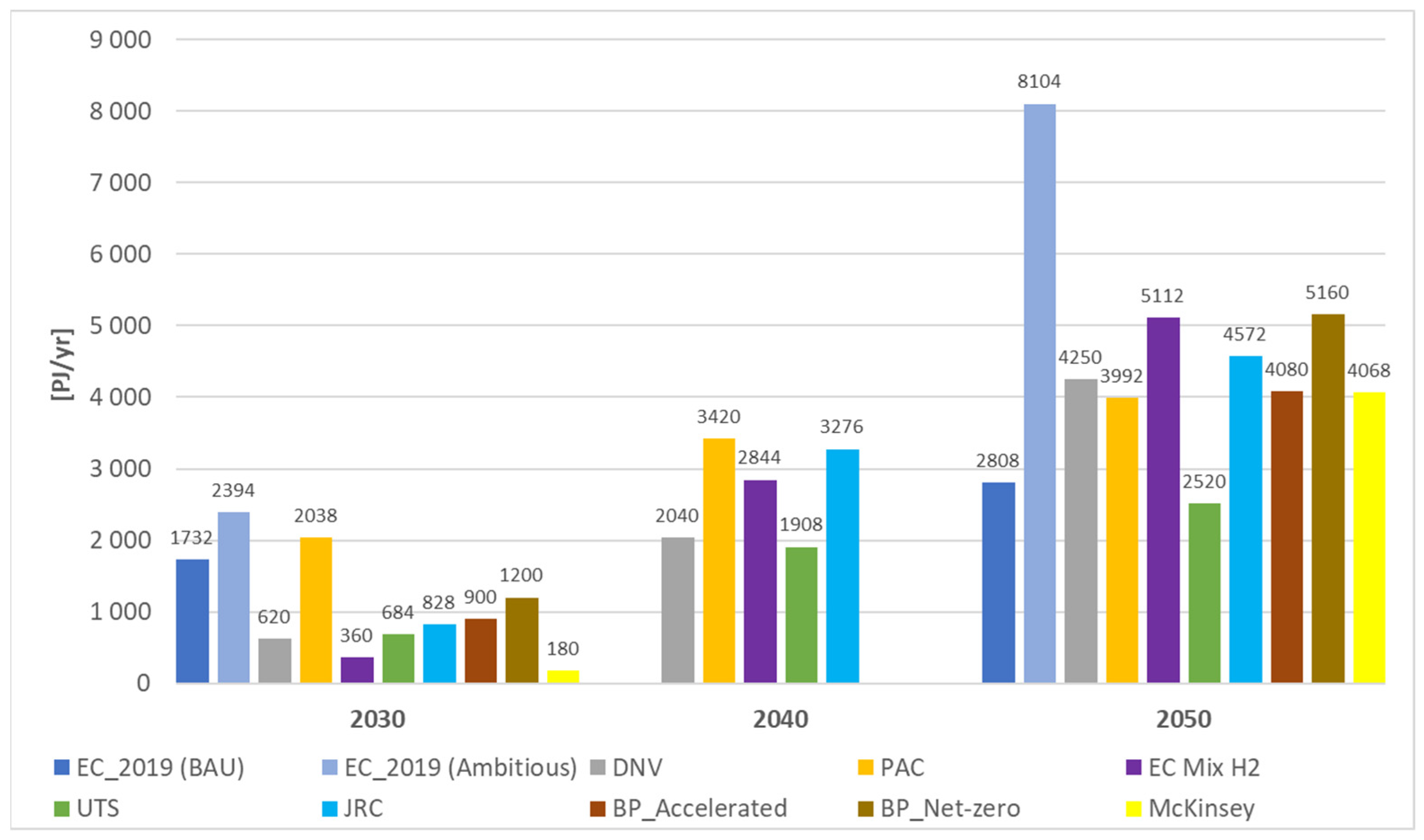
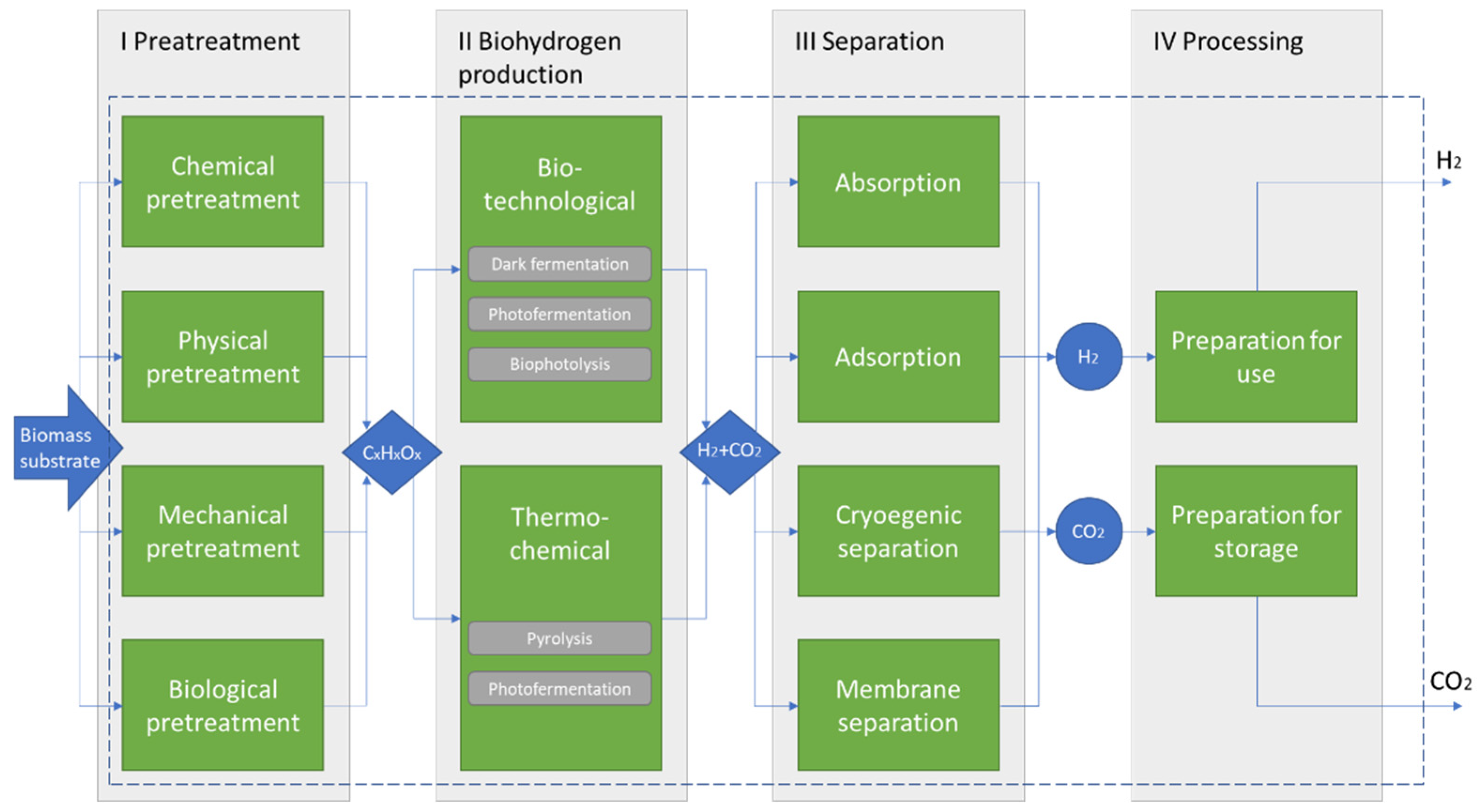

 , Brown hydrogen” (coal gasification);
, Brown hydrogen” (coal gasification);  , Grey hydrogen” (methane reforming);
, Grey hydrogen” (methane reforming);  , Blue hydrogen” (methane reforming + CCS/CCU);
, Blue hydrogen” (methane reforming + CCS/CCU);  , Green hydrogen” (electrolyzer + wind onshore PP);
, Green hydrogen” (electrolyzer + wind onshore PP);  , Green hydrogen” (electrolyzer + wind offshore PP);
, Green hydrogen” (electrolyzer + wind offshore PP);  , Green hydrogen” (electrolyzer + PV);
, Green hydrogen” (electrolyzer + PV);  , Biohydrogen” (HyBECCS).
, Biohydrogen” (HyBECCS).
 , Brown hydrogen” (coal gasification);
, Brown hydrogen” (coal gasification);  , Grey hydrogen” (methane reforming);
, Grey hydrogen” (methane reforming);  , Blue hydrogen” (methane reforming + CCS/CCU);
, Blue hydrogen” (methane reforming + CCS/CCU);  , Green hydrogen” (electrolyzer + wind onshore PP);
, Green hydrogen” (electrolyzer + wind onshore PP);  , Green hydrogen” (electrolyzer + wind offshore PP);
, Green hydrogen” (electrolyzer + wind offshore PP);  , Green hydrogen” (electrolyzer + PV);
, Green hydrogen” (electrolyzer + PV);  , Biohydrogen” (HyBECCS).
, Biohydrogen” (HyBECCS).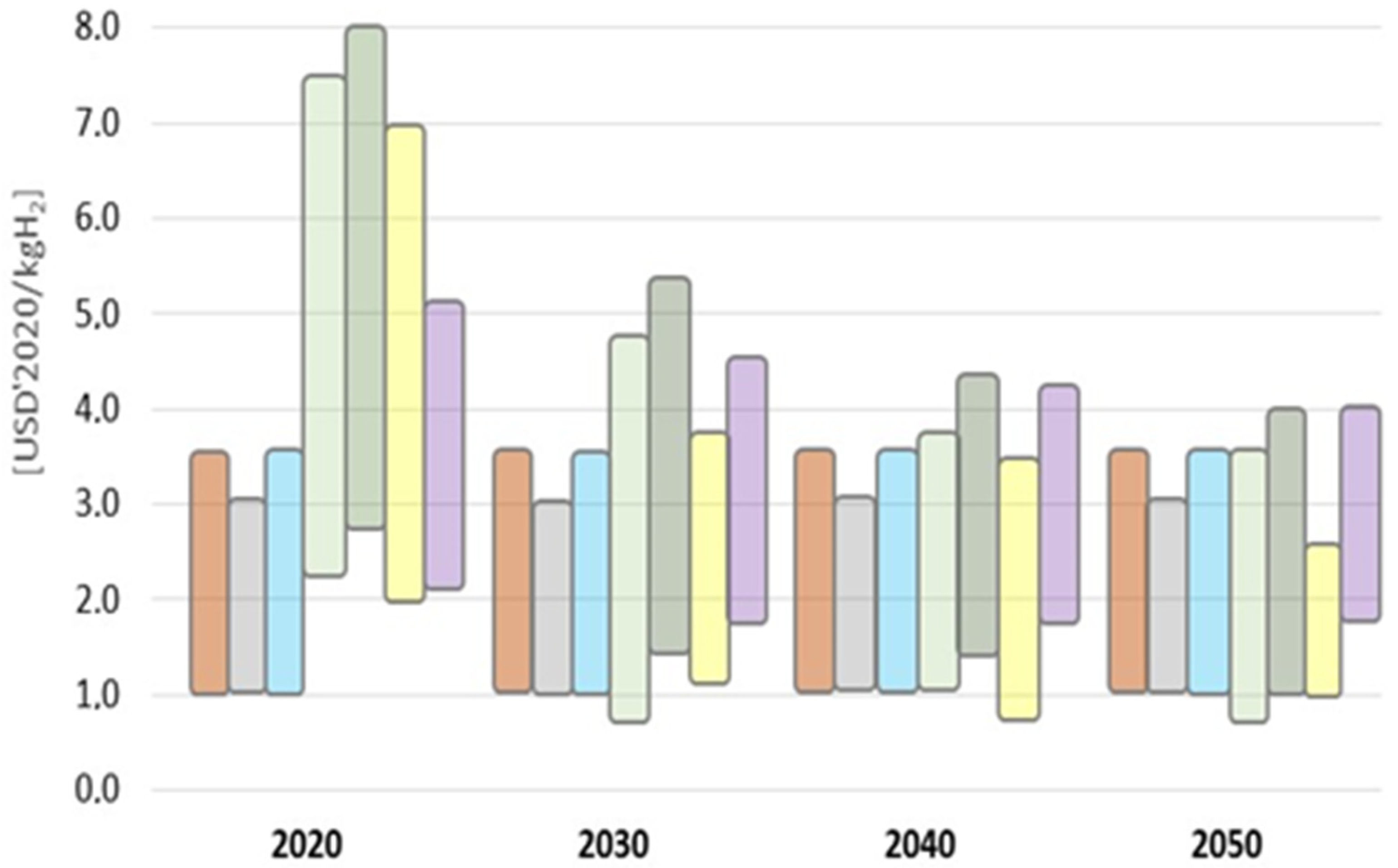
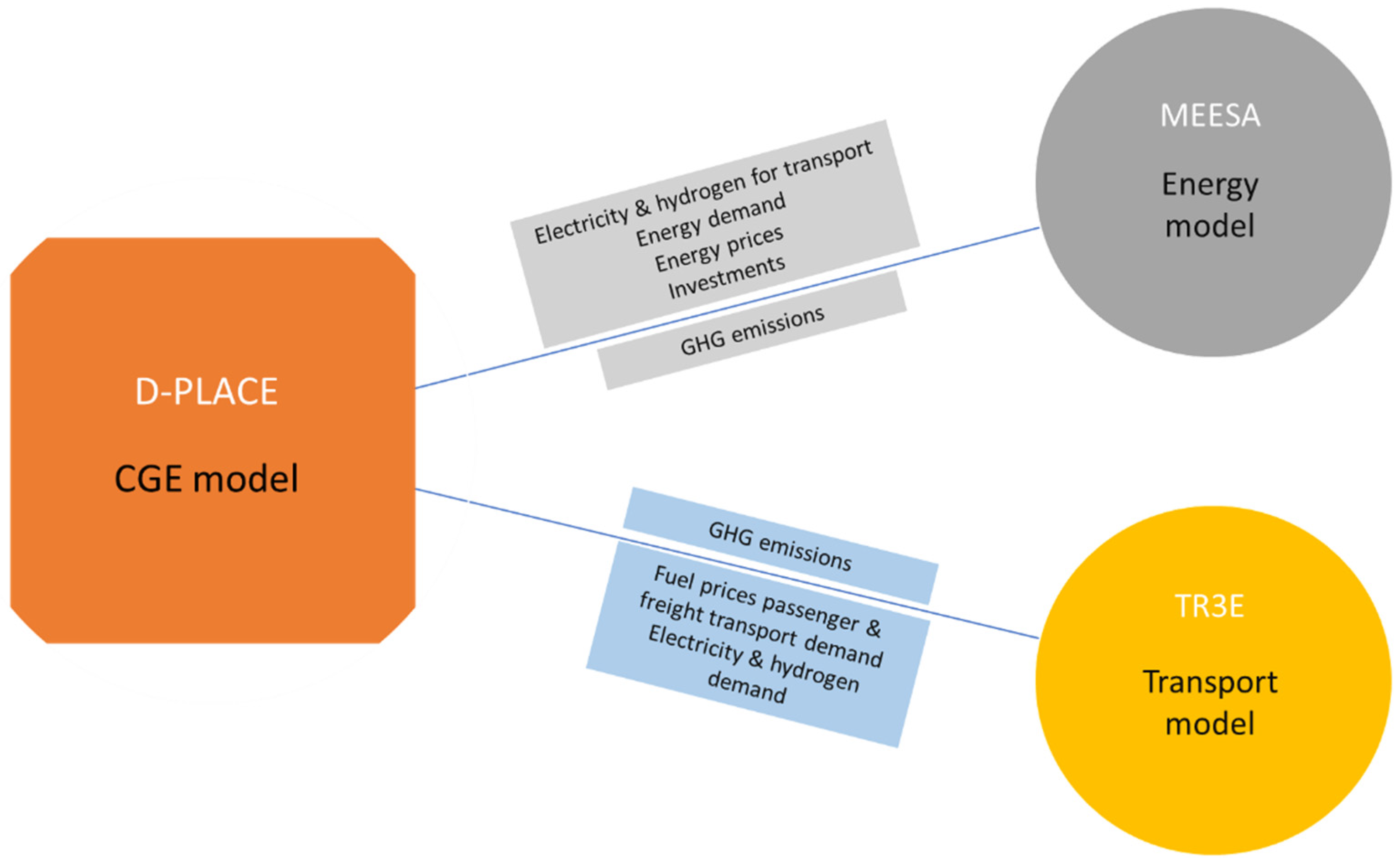
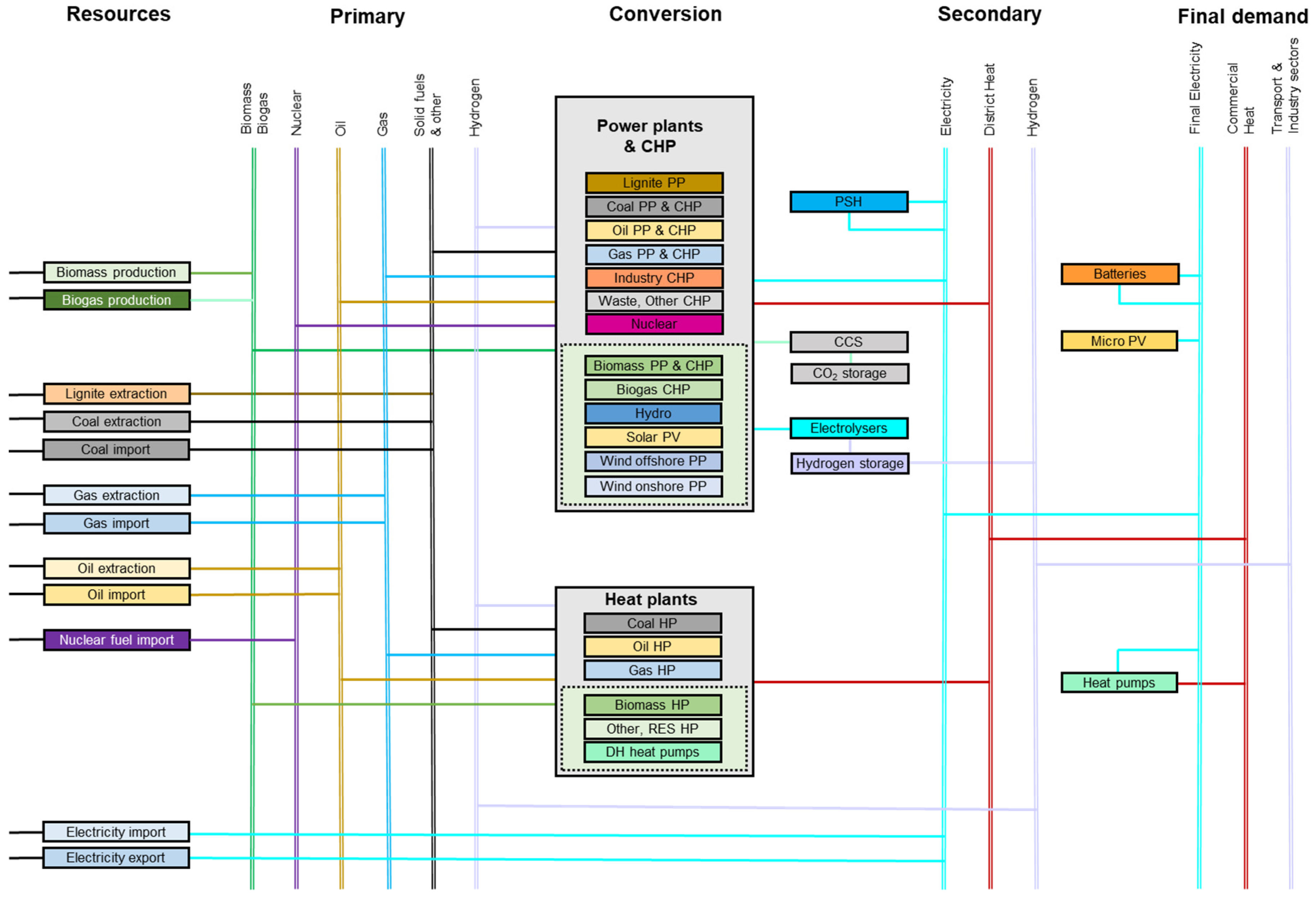



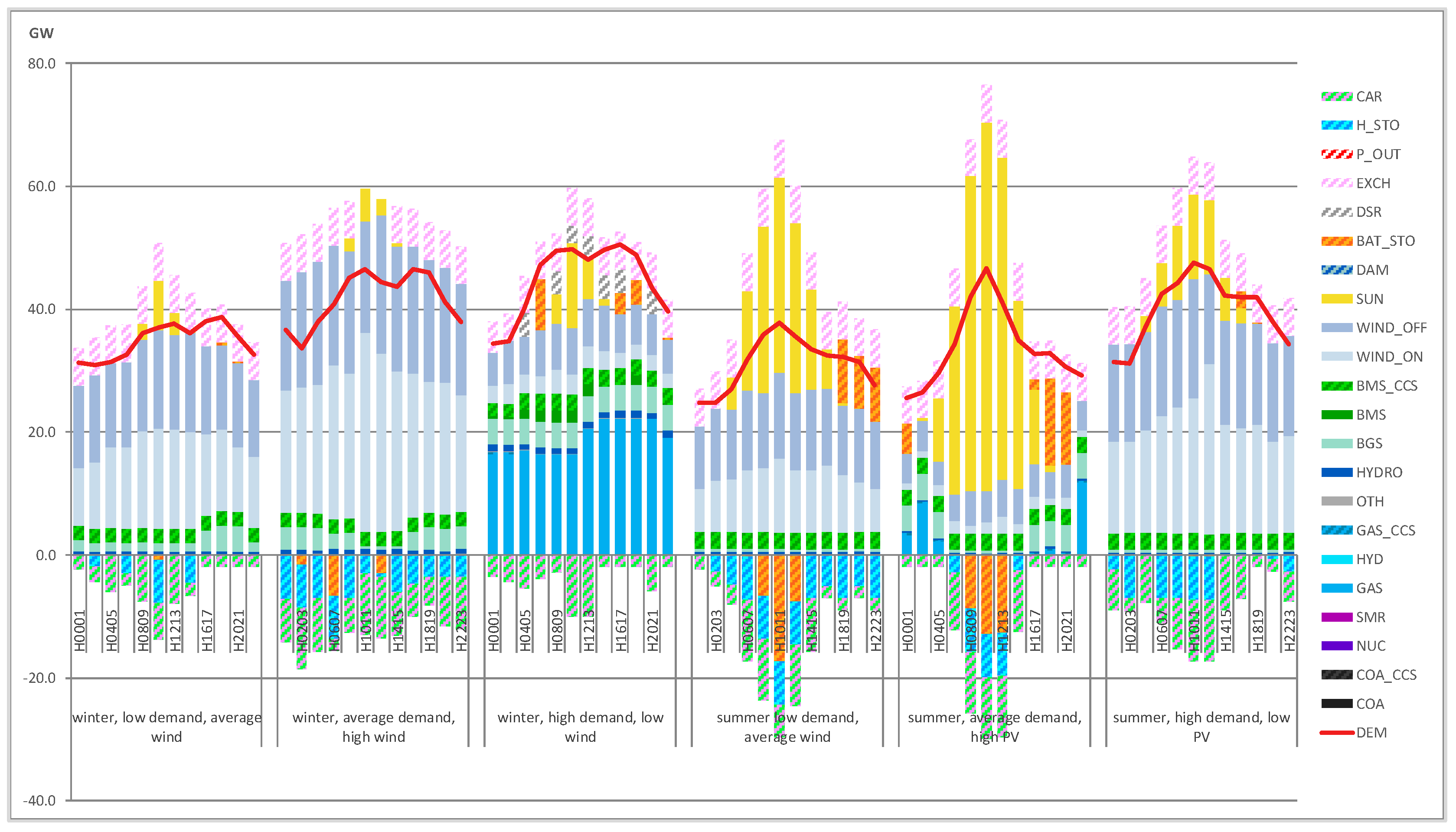


| Scenario | 2030 | 2040 | 2050 | |
|---|---|---|---|---|
| PHS (2021) | BAU | 0.8 | 61.2 | n/a |
| PHS | 23.4 | 104.5 | n/a | |
| FIT55 | 46.6 | 234.0 | n/a | |
| PWEA, LSIES (2021) | BAU | 25.2 | 212.4 | 302.4 |
| Type of Electrolyzer: | ALK | PEM | SOE |
|---|---|---|---|
| Technology maturity | Advanced | Demonstrative | R + D |
| Working temperature [°C] | 25–100 | 50–80 | 700–1000 |
| Conversion efficiency HHV [%] | 60–85 | 56–73 | 80–90 |
| Hydrogen generation [Nm3/h] | <1000 | <400 | <10 |
| Lifecycle [years] | 20–30 | 10–45 | 10–20 |
| Maximum stack life [h] | 50,000–90,000 | 30,000–50,000 | 10,000–20,000 |
| Hydrogen purity [%] | 99.800 | 99.999 | 99.999 |
| Type of Electrolyzer: | ALK | PEM | SOE |
|---|---|---|---|
| 2020 | 1050 | 1200 | 1900 |
| 2030 | 850 | 590 | 1190 |
| 2040 | 570 | 380 | 740 |
| 2050 | 490 | 320 | 590 |
| Poland | ||||||
|---|---|---|---|---|---|---|
| Sector | Year | Unit | fit | low_ccs | no_nuc | hi_hyd |
| Final | 2030 | [TWh] | 191 | 191 | 191 | 187 |
| Heat pumps + electrolyzers | 2030 | [TWh] | 3 | 2 | 3 | 9 |
| TOTAL | 2030 | [TWh] | 194 | 193 | 194 | 196 |
| Final | 2040 | [TWh] | 284 | 280 | 278 | 287 |
| Heat pumps + electrolyzers | 2040 | [TWh] | 23 | 25 | 16 | 33 |
| TOTAL | 2040 | [TWh] | 307 | 305 | 294 | 320 |
| Final | 2050 | [TWh] | 343 | 355 | 333 | 344 |
| Heat pumps + electrolyzers | 2050 | [TWh] | 81 | 77 | 37 | 85 |
| TOTAL | 2050 | [TWh] | 424 | 432 | 370 | 429 |
| EU+ | ||||||
| Sector | Year | Unit | fit | low_ccs | no_nuc | hi_hyd |
| Final | 2030 | [TWh] | 3761 | 3763 | 3761 | 3752 |
| Heat pumps + electrolyzers | 2030 | [TWh] | 80 | 79 | 78 | 234 |
| TOTAL | 2030 | [TWh] | 3841 | 3842 | 3839 | 3986 |
| Final | 2040 | [TWh] | 4722 | 4688 | 4694 | 4707 |
| Heat pumps + electrolyzers | 2040 | [TWh] | 773 | 855 | 767 | 901 |
| TOTAL | 2040 | [TWh] | 5495 | 5543 | 5461 | 5608 |
| Final | 2050 | [TWh] | 5479 | 5629 | 5540 | 5503 |
| Heat pumps + electrolyzers | 2050 | [TWh] | 1888 | 1867 | 1653 | 2196 |
| TOTAL | 2050 | [TWh] | 7367 | 7496 | 7193 | 7699 |
| Poland | ||||||
|---|---|---|---|---|---|---|
| Sector | Year | Unit | fit | low_ccs | no_nuc | hi_hyd |
| Final demand | 2030 | [PJ] | 0 | 0 | 0 | 17 |
| Energy sector | 2030 | [PJ] | 0 | 0 | 0 | 0 |
| TOTAL | 2030 | [PJ] | 0 | 0 | 0 | 17 |
| Final demand | 2040 | [PJ] | 38 | 37 | 21 | 52 |
| Energy sector | 2040 | [PJ] | 0 | 10 | 0 | 13 |
| TOTAL | 2040 | [PJ] | 38 | 47 | 21 | 65 |
| Final demand | 2050 | [PJ] | 127 | 117 | 76 | 130 |
| Energy sector | 2050 | [PJ] | 67 | 67 | 0 | 76 |
| TOTAL | 2050 | [PJ] | 194 | 184 | 76 | 206 |
| EU+ | ||||||
| Sector | Year | Unit | fit | low_ccs | no_nuc | hi_hyd |
| Final demand | 2030 | [PJ] | 157 | 157 | 154 | 608 |
| Energy sector | 2030 | [PJ] | 0 | 0 | 0 | 0 |
| TOTAL | 2030 | [PJ] | 157 | 157 | 154 | 608 |
| Final demand | 2040 | [PJ] | 1706 | 1677 | 1711 | 2096 |
| Energy sector | 2040 | [PJ] | 292 | 583 | 277 | 273 |
| TOTAL | 2040 | [PJ] | 1998 | 2260 | 1988 | 2369 |
| Final demand | 2050 | [PJ] | 3763 | 3440 | 3383 | 4384 |
| Energy sector | 2050 | [PJ] | 1349 | 1599 | 1066 | 1601 |
| TOTAL | 2050 | [PJ] | 5112 | 5039 | 4449 | 5985 |
Disclaimer/Publisher’s Note: The statements, opinions and data contained in all publications are solely those of the individual author(s) and contributor(s) and not of MDPI and/or the editor(s). MDPI and/or the editor(s) disclaim responsibility for any injury to people or property resulting from any ideas, methods, instructions or products referred to in the content. |
© 2023 by the authors. Licensee MDPI, Basel, Switzerland. This article is an open access article distributed under the terms and conditions of the Creative Commons Attribution (CC BY) license (https://creativecommons.org/licenses/by/4.0/).
Share and Cite
Tatarewicz, I.; Skwierz, S.; Lewarski, M.; Jeszke, R.; Pyrka, M.; Sekuła, M. Mapping the Future of Green Hydrogen: Integrated Analysis of Poland and the EU’s Development Pathways to 2050. Energies 2023, 16, 6261. https://doi.org/10.3390/en16176261
Tatarewicz I, Skwierz S, Lewarski M, Jeszke R, Pyrka M, Sekuła M. Mapping the Future of Green Hydrogen: Integrated Analysis of Poland and the EU’s Development Pathways to 2050. Energies. 2023; 16(17):6261. https://doi.org/10.3390/en16176261
Chicago/Turabian StyleTatarewicz, Igor, Sławomir Skwierz, Michał Lewarski, Robert Jeszke, Maciej Pyrka, and Monika Sekuła. 2023. "Mapping the Future of Green Hydrogen: Integrated Analysis of Poland and the EU’s Development Pathways to 2050" Energies 16, no. 17: 6261. https://doi.org/10.3390/en16176261
APA StyleTatarewicz, I., Skwierz, S., Lewarski, M., Jeszke, R., Pyrka, M., & Sekuła, M. (2023). Mapping the Future of Green Hydrogen: Integrated Analysis of Poland and the EU’s Development Pathways to 2050. Energies, 16(17), 6261. https://doi.org/10.3390/en16176261







